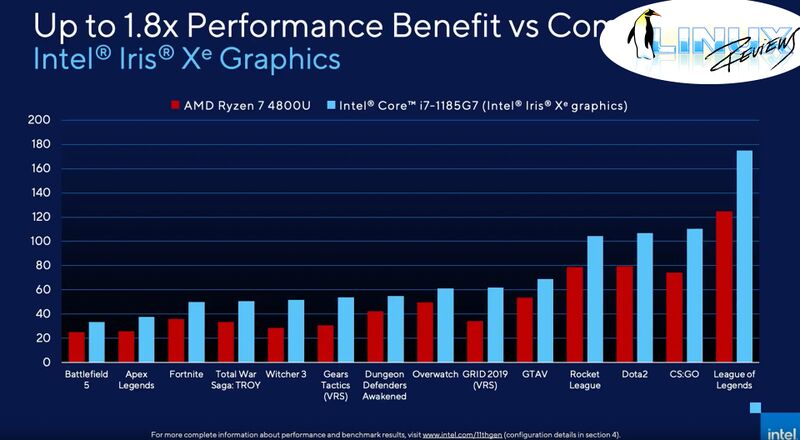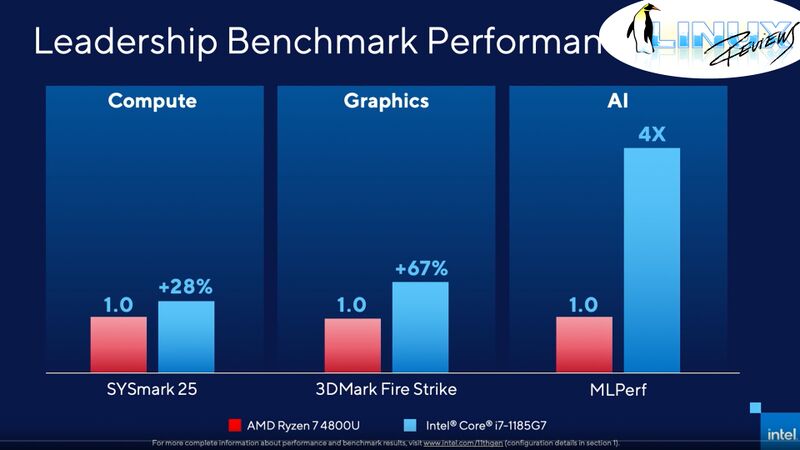Intel Unveils Tiger Lake Laptop CPU Line-Up With Impressive Graphics Performance Numbers
Intel has unveiled its 11th generation mobile processors. The new quad and dual-core mobile processors made on Intel's 10nm "SuperFin" process node have all-core turbo clock speeds between 3 and 4.3 GHz and max single core turbo speeds between 3.5 and 4.8 GHz. The claims Intel is making about their integrated Iris Xe graphics chips performance are aggressive. Their story is that the integrated gen12 Intel Xe graphics part of their top-of-the-line 1185G7 IPU laptop processor has 63% better performance than a AMD Ryzen 7 4800U processor.
written by 林慧 (Wai Lin) 2020-09-03 - last edited 2020-09-07. © CC BY

Intel marketing story is that their new Iris Xe graphics parts has gaming performance superior to the otherwise comparable AMD Ryzen 7 4700U processor.
Intel processors are not known for their amazing graphics performance. Their integrated graphics parts have never been good for more than desktop work, casual web browsing and video playback. Intel's story is that this has changed with the launch of their 11th generation Tiger Lake parts with gen12 Iris Xe graphics. Intel claims their top of the line 1185G7 IPU (Intel processing unit?), with 96 GPU execution units and a max GPU clock speed of 1.35 GHz, has 63% better graphics performance than the AMD Ryzen 7 4800U APU launched in January 2020.

Intel marketing slide shown during their Tiger Lake launch.
Intel is in a good position graphics-wise if their graphics performance claims hold water. Intel claims the i7-1185G7 is good for 110 FPS in CS:GO, 107 FPS in Dota and 104 FPS in Rocket League, all at at 1080p medium. Some of their other numbers are not quite that impressive. Their numbers claim it can do 39 FPS in PUBG at 1080p low, 33 FPS in Battlefield 5 at 1080p medium and 50 FPS in Fortnite at 1080p low. Intel claims the sub-60 fps numbers provide a "playable" experience.
The Iris Xe chips contain something Intel calls "Deep Learning Boost" (DL Boost) extensions which is likely why their MLPref (a AI benchmarking suite) numbers claim it is "4X" faster than the AMD Ryzen 7 4800U in that particular benchmark.
The Line-Up[edit]
Mobile processors (UP3-class)[edit]
| Processor
branding |
Model | Cores
(threads) |
Base freq | Max Turbo freq | GPU | Smart
cache |
TDP | Memory
support |
Price | |||
|---|---|---|---|---|---|---|---|---|---|---|---|---|
| Single Core | All Core | Series | EUs | Max
freq | ||||||||
| Core i7 | 1185G7 IPU | 4 (8) | 3.0 GHz | 4.8 GHz | 4.3 GHz | Iris Xe | 96 | 1.35 GHz | 12 MiB | 12-28 W | DDR4-3200 LPDDR4X-4266 LPDDR5-5400 |
$426 |
| 1165G7
with IPU |
2.8 GHz | 4.7 GHz | 4.1 GHz | 1.30 GHz | $426 | |||||||
| Core i5 | 1135G7
with IPU |
2.4 GHz | 4.2 GHz | 3.8 GHz | 80 | 8 MiB | $309 | |||||
| Core i3 | 1125G4 | 2.0 GHz | 3.7 GHz | 3.3 GHz | UHD
Graphics |
48 | 1.25 GHz | DDR4-3200
LPDDR4X-3733 |
||||
| 1115G4
with IPU |
2 (4) | 3.0 GHz | 4.1 GHz | 6 MiB | $281 | |||||||
Mobile processors (UP4-class)[edit]
| Processor
branding |
Model | Cores
(threads) |
Base freq | Max Turbo freq | GPU | Smart
cache |
TDP | Memory
support |
Price | |||
|---|---|---|---|---|---|---|---|---|---|---|---|---|
| Single Core | All Core | Series | EUs | Max
freq | ||||||||
| Core i7 | 1160G7 IPU | 4 (8) | 1.2 GHz | 4.4 GHz | 3.6 GHz | Iris Xe | 96 | 1.10 GHz | 12 MiB | 7-15 W | LPDDR4X-4266 | |
| Core i5 | 1130G7 IPU | 1.1 GHz | 4.0 GHz | 3.4 GHz | 80 | 8 MiB | ||||||
| Core i3 | 1120G4 | 3.5 GHz | 3.0 GHz | UHD
Graphics |
48 | |||||||
| 1110G4 IPU | 2 (4) | 1.8 GHz | 3.9 GHz | 6 MiB | ||||||||
All the new Tiger Lake processors have PCI Express 4.0, Thunderbolt 4, USB 4, 802.11ax Wifi ("Wifi 6"), indirect branch tracking and a new VP2INTERSECT AVX 512 instruction.
The hardware video encoding and decoding circuitry in the Iris Xe graphics chips can do MPEG/AVC, HEVC and 10-bit VP9 hardware encoding and decoding. AV1 and 12-bit VP9 decoding is also supported. VAAPI patches providing Linux support were merged two weeks ago.
The Linux kernel has had support for Tiger Lake processors since Linux 5.4 was released in November 2019 so any Linux distribution should work fine with the new Tiger Lake laptops and notebooks when they become available in retail stores.


Enable comment auto-refresher
Intgr
Permalink |